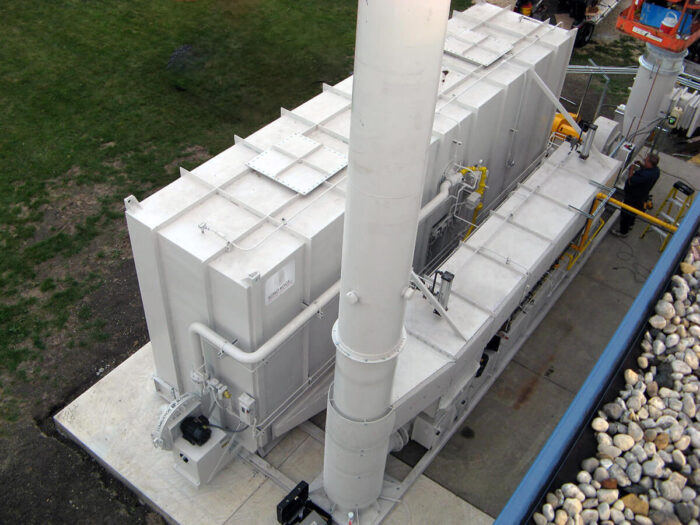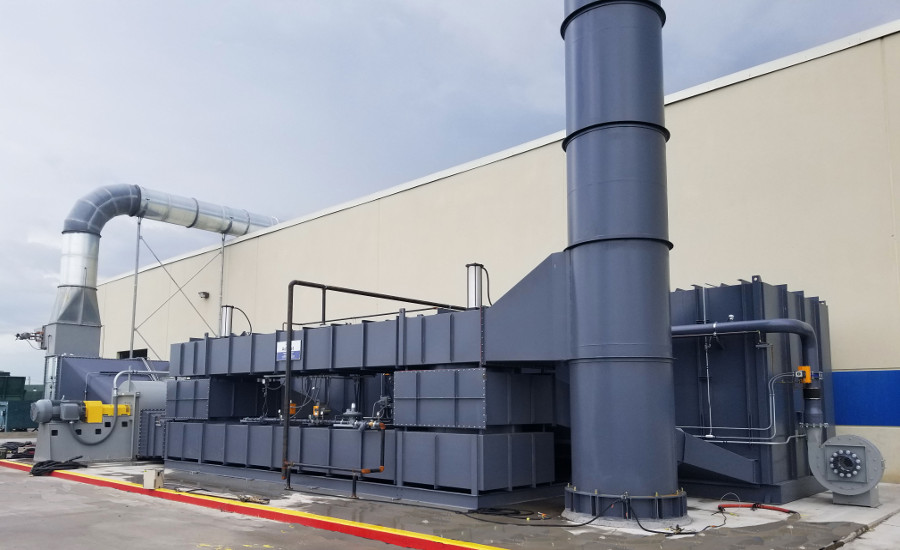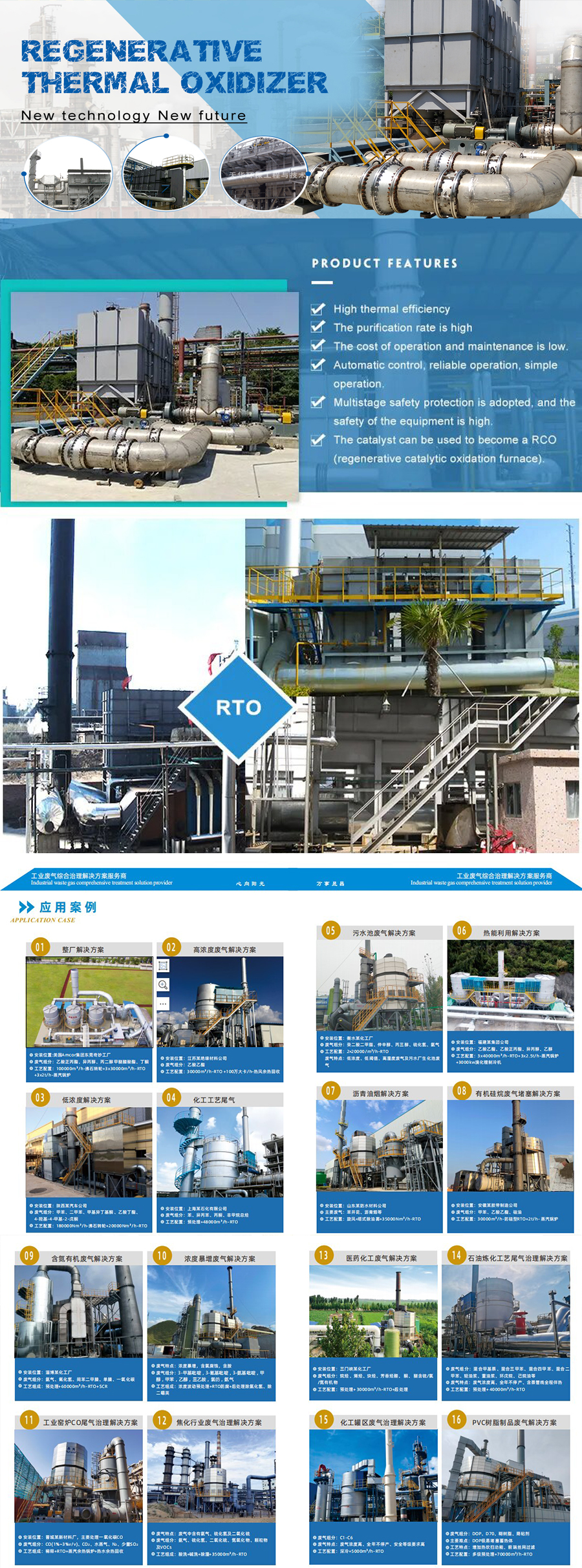基本訊息
型號
RTO
類型
環境監測儀器
主要功能
廢氣去除
應用
化工
品牌
雷德桑特
清潔效率
99.8%
狀態
新的
商標
雷德桑特
運輸套餐
薄膜包裹
起源
中國 浙江
產品描述
杭州瑞德森機械有限公司;,;有限公司;專業開發製造創新粉末冷卻造粒機械及相關工業廢氣處理設備。具有近20年的生產歷史;我們在中國20多個省份擁有良好的市場;部分產品出口沙烏地阿拉伯、新加坡、墨西哥、巴西,;西班牙,;美國,;俄羅斯和韓國; ETC。
規格:;
* 比現有設施更緊湊
* 營運成本低
* 設施使用壽命長
* 壓力無變化
目的:;
燃燒揮發性有機化合物(VOC)的節能係統;利用熱量產生廢氣;採用陶瓷蓄熱材料(催化劑)收集99.;8%以上的廢氣餘熱;表面積大,壓力損失低;
應用:;
1.;塗裝乾燥工藝
2.;金屬印刷工藝
3.;纖維乾燥過程
4.;膠帶工藝
5.;廢棄物處理工藝
6.;半導體製造工藝
7.;抽煙,;糖果和烘焙過程
8.;石化過程;
9.;醫藥和食品製造過程;
10.;其他VOC產生過程
優點:;
* 比現有設施更緊湊
* 壓力無變化
* 熱回收率高(95%以上);
* 完善的VOC處理(99.;8%以上);
* 設施使用壽命長
* 營運成本低
* 可製作圓形或四邊形
一般描述與特點:;
1.;工作原理
透過旋轉旋轉閥連續改變流量的操作方法
2.;過程壓力變化
由於旋轉閥的旋轉,風向會發生順序變化,因此壓力不會變化
3.;投資成本
約 70% 的床型
4.;安裝空間
它是單一容器,因此結構緊湊,需要的安裝空間較小。
5.;維護
由於旋轉閥是唯一的 1 個移動部件,因此易於維護。
旋轉閥由於旋轉速度低,密封件很少磨損;
6.;穩定
在此過程中沒有風險,因為即使旋轉閥出現故障,它也始終打開。
7.;處理效率
即使長時間運行,密封件也很少磨損,處理效率得以維持;
地址:浙江省杭州市經濟開發區振新中路3號
業務類型: 製造商/工廠, 貿易公司
業務範圍:化工、電氣電子、製造加工機械、安全防護
管理系統認證:ISO 9001
主要產品:造粒機、刨片機、造粒機、造粒機、化學造粒機、Vocs
公司簡介:杭州瑞德森機械有限公司,前身為杭州新特塑膠機械廠,是一家專業生產創新塑膠回收機械的企業。憑藉近20年的經驗,我們在國內20個省市自治區擁有良好的市場,部分產品出口到印尼、俄羅斯、越南等。管材撕碎回收生產線、連續退火鍍錫機、QX型PET、PE及皮殼清洗生產線、SDP雙軌塑膠回收破碎機、SJ熱切造粒機組、PVC管(五葉)生產線、PVC異型材產品門窗生產線、水中顆粒生產線以及塑膠和回收粉碎機。我們獲得了5項技術專利。
本公司注重技術改造,引進國內外先進技術,不斷開發新產品。我們的宗旨是挑戰高品質,提供最好的產品。我們正在努力實現我們的口號。讓客戶滿意是我們永恆的追求。
我們正在尋找海外客戶或代理商。如果您對我們的提案感興趣,請讓我們知道我們的哪種產品最有可能吸引您或您的客戶。如果您能給我們一些關於我們產品的市場前景的想法,我們將不勝感激。我們希望盡快收到您的有利訊息!我們的目標是希望現在或不久的將來能與您建立良好的關係。如果您有任何問題或要求,請隨時與我們聯繫。
我們也真誠歡迎您來本公司洽談業務、洽談業務。為進一步拓展市場與客戶,本公司以全新的經營理念-品質、榮譽、服務,以全新的品牌姿態迎接國內外客戶。我們正在尋找 ISO 90001 管理品質系統來滿足客戶的要求!

What are the limitations of regenerative thermal oxidizers?
While regenerative thermal oxidizers (RTOs) are widely used for air pollution control, they do have certain limitations that should be considered. Here are some key limitations of RTOs:
- High Capital Cost: RTOs typically have higher capital costs compared to other air pollution control technologies. The complexity of the regenerative heat exchanger system, which enables high energy efficiency, can contribute to the higher upfront investment required for RTO installation.
- Space Requirements: RTOs generally require a larger footprint compared to some other air pollution control devices. The presence of regenerative heat exchangers, combustion chambers, and associated equipment necessitates adequate space for installation. This can be a limitation for industries with limited available space.
- High Energy Consumption during Startup: RTOs require a certain amount of time and energy to reach their optimal operating temperature during startup. This initial energy consumption can be relatively high, and it is important to consider this aspect when planning the operational schedule and energy management of an RTO system.
- Limitations in Handling Low Concentration VOCs: RTOs may have limitations in effectively treating low concentration volatile organic compounds (VOCs). If the VOC concentrations in the exhaust gas are too low, the energy required to maintain the necessary temperature for oxidation may be higher than the energy released during the combustion process. In such cases, other air pollution control technologies or pre-concentration techniques may be more suitable.
- Particulate Matter Control: RTOs are not specifically designed for controlling particulate matter emissions. While they may provide some incidental removal of fine particulate matter, their removal efficiency for particulates is generally lower compared to dedicated particulate control devices such as fabric filters (baghouses) or electrostatic precipitators.
- Chemically Corrosive Gases: RTOs may not be suitable for treating exhaust gases containing highly corrosive compounds. The high temperatures within the RTO can accelerate corrosion of materials, and the presence of corrosive gases may require additional corrosion-resistant materials or alternative air pollution control technologies.
Despite these limitations, RTOs remain an effective and widely used technology for the destruction of gaseous pollutants in various industrial applications. It is important to evaluate the specific requirements, characteristics of the exhaust gases, and environmental regulations when considering the implementation of an RTO system.

What are the typical construction materials used in regenerative thermal oxidizers?
Regenerative thermal oxidizers (RTOs) are constructed using various materials that can withstand the high temperatures, corrosive environments, and mechanical stresses encountered during operation. The choice of materials depends on factors such as the specific design, process conditions, and the types of pollutants being treated. Here are some typical construction materials used in RTOs:
- Heat Exchangers: The heat exchangers in RTOs are responsible for transferring heat from the outgoing exhaust gas to the incoming process air or gas stream. The construction materials for heat exchangers often include:
- Ceramic Media: RTOs commonly use structured ceramic media, such as ceramic monoliths or ceramic saddles. These materials have excellent thermal properties, high resistance to thermal shock, and good chemical resistance. Ceramic media provide a large surface area for efficient heat transfer.
- Metallic Media: Some RTO designs may incorporate metallic heat exchangers made from alloys such as stainless steel or other heat-resistant metals. Metallic media offer robustness and durability, particularly in applications with high mechanical stresses or corrosive environments.
- Combustion Chamber: The combustion chamber of an RTO is where the oxidation of pollutants takes place. The construction materials for the combustion chamber should be able to withstand the high temperatures and corrosive conditions. Commonly used materials include:
- Refractory Lining: RTOs often have refractory lining in the combustion chamber to provide thermal insulation and protection. Refractory materials, such as high-alumina or silicon carbide, are chosen for their high-temperature resistance and chemical stability.
- Steel or Alloys: The structural components of the combustion chamber, such as the walls, roof, and floor, are typically made of steel or heat-resistant alloys. These materials offer strength and stability while withstanding the high temperatures and corrosive gases.
- Ductwork and Piping: The ductwork and piping in an RTO transport the exhaust gas, process air, and auxiliary gases. The materials used for ductwork and piping depend on the specific requirements, but commonly used materials include:
- Mild Steel: Mild steel is often used for ductwork and piping in less corrosive environments. It provides strength and cost-effectiveness.
- Stainless Steel: In applications where corrosion resistance is crucial, stainless steel, such as 304 or 316 grades, may be used. Stainless steel offers excellent resistance to many corrosive gases and environments.
- Corrosion-Resistant Alloys: In highly corrosive environments, corrosion-resistant alloys like Hastelloy or Inconel may be employed. These materials provide exceptional resistance to a wide range of corrosive chemicals and gases.
- Insulation: Insulation materials are used to minimize heat loss from the RTO and ensure energy efficiency. Common insulation materials include:
- Ceramic Fiber: Ceramic fiber insulation offers excellent thermal resistance and low thermal conductivity. It is often used in RTOs to reduce heat loss and improve overall energy efficiency.
- Mineral Wool: Mineral wool insulation provides good thermal insulation and sound absorption properties. It is commonly used in RTOs to reduce heat loss and enhance safety.
It is important to note that the specific materials used in RTO construction may vary depending on factors such as the process requirements, temperature range, and corrosive nature of the gases being treated. Manufacturers of RTOs typically select appropriate materials based on their expertise and the specific application.

Can regenerative thermal oxidizers reduce odor emissions?
Regenerative thermal oxidizers (RTOs) are effective in reducing odor emissions from industrial processes. While their primary purpose is to control and destroy volatile organic compounds (VOCs) and hazardous air pollutants (HAPs), they can also effectively mitigate odorous compounds.
Here’s how RTOs contribute to odor reduction:
- Oxidation of Odorous Compounds: RTOs operate at high temperatures, typically ranging from 1,400 to 1,800 degrees Fahrenheit (760 to 980 degrees Celsius). These elevated temperatures facilitate the complete oxidation of odorous compounds, breaking them down into harmless byproducts, such as carbon dioxide and water vapor. The thermal oxidation process ensures the destruction of odor-causing molecules.
- 破壞效率高: RTOs are designed to achieve high destruction efficiencies, often exceeding 99%. This means that the vast majority of odorous compounds are effectively eliminated during the combustion process, resulting in a significant reduction in odor emissions.
- 保留時間: RTOs provide a sufficiently long retention time for the exhaust gases within the combustion chamber. This allows for thorough mixing and residence time necessary for the complete oxidation of odorous compounds. The extended contact time ensures that the odorous molecules have sufficient exposure to the high temperatures, resulting in their destruction.
- Control of VOCs: Many odorous compounds are also VOCs. By effectively controlling and destroying VOC emissions, RTOs indirectly reduce odor emissions as well. The comprehensive destruction of VOCs prevents their release into the atmosphere, thereby minimizing the associated odors.
- Monitoring and Optimization: Proper monitoring and optimization of RTO operation can further enhance odor reduction. By continuously monitoring the process parameters, such as temperature, airflow, and pollutant concentrations, adjustments can be made to optimize the performance of the RTO and ensure effective odor control.
It’s important to note that while RTOs are effective in reducing odor emissions, the specific odor compounds and their concentrations in the exhaust stream can influence the overall odor control efficiency. Additionally, proper design, operation, and maintenance of the RTO are crucial for achieving optimal odor reduction.

editor by Dream 2024-12-02
